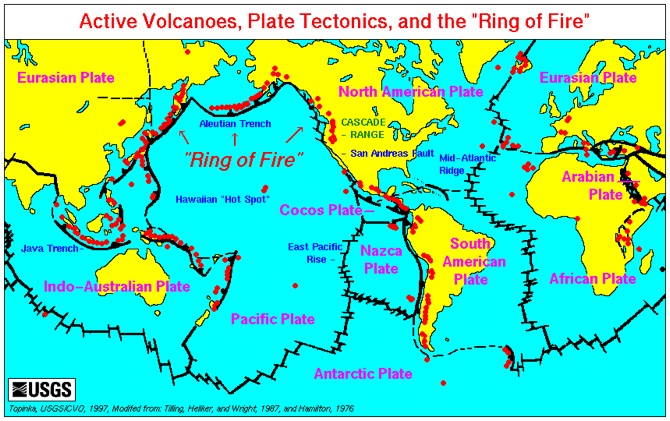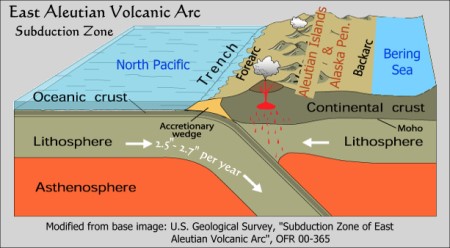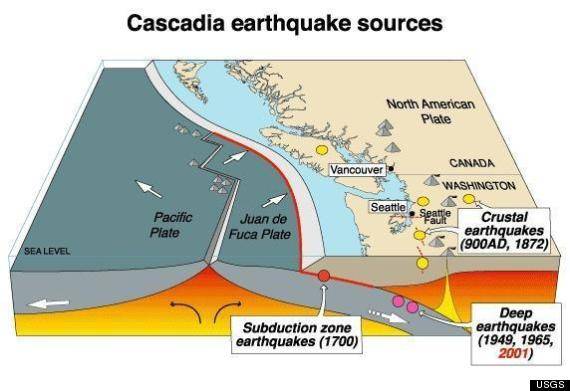usmbguest5318
Gold Member
There was a 7.9 magnitude quake just off part of America's western coast today. Fortunately, it happened in the ocean rather than on land, thus limiting the impact of the quake's full force to the floor of the ocean at the quake's epicenter, and the faultline along which it happened is a slip fault rather than a "normal" fault or thrust fault (or an oblique fault).
Does that mean we are clear for "a good long while" before the next big quake that can affect the western U.S? Not in the least.

Today's quake happened roughly where the "point" is just right of the words "Aleutian Trench. It resulted from horizontal movement of two chucks of crust. Now, I'm no geologist, but from what I understand about how plates move, the plates of Earth's crust don't exactly move freely, so to speak. They move more like an egg in a skillet might when one edge is stuck and one can stretch another part of the egg a bit before the stuck part releases.
Thinking about that, and knowing that the Pacific Plate's (PP) "left and right" edges will eventually beneath the North American Plate (NAP) and Eurasian Plate (EP) due to the Earth "belching up" new ground at the Mid-Atlantic Ridge and pushing that land left and right, thus pushing the NAP and EP away from one another on America's East Coast and toward one another on the opposite one, it seems to me that the rest of the PP is relatively soon going to have to "let go" and slip a bit further beneath the NAP.
Inasmuch as the horizontal slip this morning was 7.9 on the Richter scale, it seems that the remainder of the North American west coast is due to soon enough see one of two general outcomes:
Some readers here may be aware that the San Andreas Fault is a slip-fault rather than thrust fault. That's because, conceptually, it's part of the Juan de Fuca-Gorda-PP-NAP system rather the the PP-NAP-EP system, but as one can see, they're all related. There are actually some even smaller plates, and they move too, and their doing so can be equally devastating to life, limb and property. (Tree limbs, on the other hand don't suffer too badly if they are securely enough rooted in the ground, or flexible enough.)
When one moves, the ones adjacent to it is sure to move sooner or later. So, though I opened this discussion by, for simplicity's sake, referring to the PP, today's quake, strictly speaking, was in fact the Juan de Fuca Plate (JDF)slipping. That it was bodes even less well for the WA, OR and CA because what the JDF's actual movement is diagonally "up and under" the NAP and the PP slides northward as it does so.
If after reading that one is thinking "Holy 'Domino Effect, Batman," one "gets it." We ducked a "bullet" today, but, give it time, for there's no way round the fact that the "barrel" is locked and loaded, as it were, and all of that combined, not anything having to do with politics, is why, for as much as I love the weather in CA, OR, and WA, there's no way I'd live there.
Does that mean we are clear for "a good long while" before the next big quake that can affect the western U.S? Not in the least.

Thinking about that, and knowing that the Pacific Plate's (PP) "left and right" edges will eventually beneath the North American Plate (NAP) and Eurasian Plate (EP) due to the Earth "belching up" new ground at the Mid-Atlantic Ridge and pushing that land left and right, thus pushing the NAP and EP away from one another on America's East Coast and toward one another on the opposite one, it seems to me that the rest of the PP is relatively soon going to have to "let go" and slip a bit further beneath the NAP.
Inasmuch as the horizontal slip this morning was 7.9 on the Richter scale, it seems that the remainder of the North American west coast is due to soon enough see one of two general outcomes:
- A series of little quakes that happen to let another part of the PP to "catch up" with the rest of it that has relatively recently moved.
- A huge quake that more or less does all the "catching up" at once.
Some readers here may be aware that the San Andreas Fault is a slip-fault rather than thrust fault. That's because, conceptually, it's part of the Juan de Fuca-Gorda-PP-NAP system rather the the PP-NAP-EP system, but as one can see, they're all related. There are actually some even smaller plates, and they move too, and their doing so can be equally devastating to life, limb and property. (Tree limbs, on the other hand don't suffer too badly if they are securely enough rooted in the ground, or flexible enough.)
When one moves, the ones adjacent to it is sure to move sooner or later. So, though I opened this discussion by, for simplicity's sake, referring to the PP, today's quake, strictly speaking, was in fact the Juan de Fuca Plate (JDF)slipping. That it was bodes even less well for the WA, OR and CA because what the JDF's actual movement is diagonally "up and under" the NAP and the PP slides northward as it does so.
If after reading that one is thinking "Holy 'Domino Effect, Batman," one "gets it." We ducked a "bullet" today, but, give it time, for there's no way round the fact that the "barrel" is locked and loaded, as it were, and all of that combined, not anything having to do with politics, is why, for as much as I love the weather in CA, OR, and WA, there's no way I'd live there.







